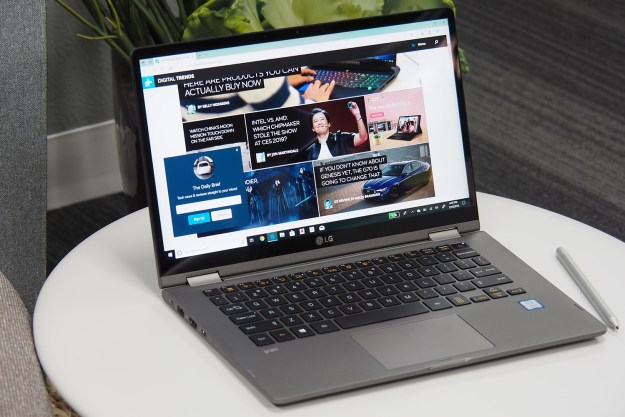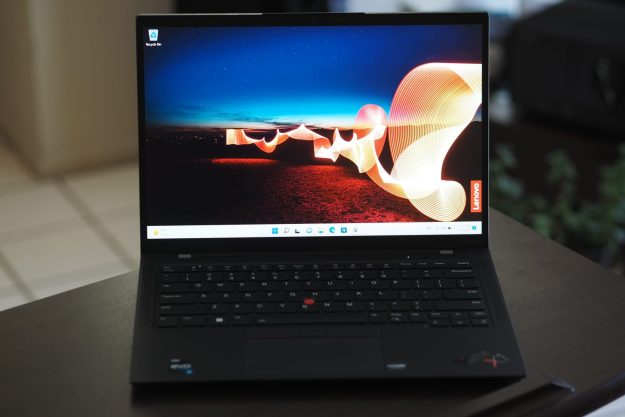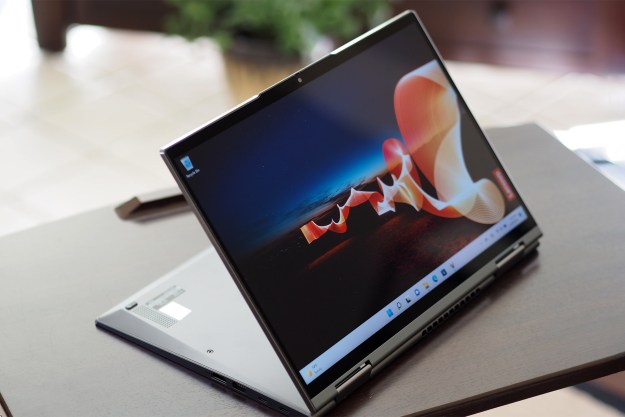
“The LG Gram 14 2-in-1 is incredibly lightweight, all while delivering record-breaking battery life.”
- Light yet sturdy construction
- Good productivity performance
- Spectacular battery life
- Very good input options
- No Thunderbolt 3 limits expansion options
- SATA SSD is disappointing
LG has been crafting some of the lightest laptops around. That’s why the company branded them “Gram” laptops, after all. The LG Gram 14 2-in-1 continues the tradition and marks the company’s first effort at moving beyond light laptops into the convertible space.
- It feels like it’s made of plastic, but it’s not
- The keyboard might be shallow, but it’s precise
- A decidedly average display, and quality sound that’s a little quiet
- Productivity performance is well-covered
- Integrated graphics mean casual gaming – and no more
- Where did all this battery come from?
- Our Take
We reviewed the only configuration that LG is selling, equipped with an 8th-generation quad-core “Whiskey Lake” Core i7-8565U, 16GB of RAM, a 512GB SATA solid-state drive (SSD), and a 14-inch Full HD (1,920 x 1080 or 157 PPI) display. At $1,500, that places the Gram 14 2-in-1 solidly in premium laptop territory.
LG has a focus on lightness, and that carries over to its first 2-in-1. Is that enough to compete with some excellent established competition?
It feels like it’s made of plastic, but it’s not
The first thing you notice when you hold the Gram 14 in your hand is how light is. Surprise! Just kidding, that’s exactly what we expected. At 2.5 pounds, this 2-in-1 isn’t as incredibly light as the company’s clamshell laptops like the Gram 15 that’s just 2.4 pounds with a 15.6-inch display. But it’s nevertheless noticeably lighter than the HP Spectre x360 13 (2.78 pounds) and the Lenovo Yoga C930 (3.0 pounds). That matters most for a 2-in-1 that might be converted to tablet format and carried around – you’re more likely to use the Gram 14 this way than some heavier 2-in-1s.
That low weight is thanks to a magnesium alloy that kind of feels like plastic but is nevertheless a lot tougher. LG tested the Gram 14 against MIL-STD-810g military standards for robustness, making it stronger than you might think given its lack of heft. And it feels like it for the most part, with the lid resisting bending and the keyboard deck showing no signs of flex. There’s only some springiness when pushing on the top of the lid and on the bottom. The Gram 14 doesn’t have the tank-like rigidity of the Yoga C930, but it evokes confidence nonetheless.
At the same time, the Gram 14’s aesthetic is very understated, with LG’s usual matte gray color scheme that sports only a shiny Gram label on the display for bling. The keyboard font adds a little flair, oddly enough, but otherwise this is a laptop that doesn’t want to stand out. In this regard, it’s a lot more like the staid Yoga C930 than the gregarious Spectre x360. Even the Dell XPS 13, among clamshell laptops, has far more panache.
The first thing you notice when you hold the Gram 14 in your hand is light it is.
We’re not faulting the Gram 14, mind you. It’s a fine look for anyone who isn’t trying to make a fashion statement with their laptop.
This is a 2-in-1, and so the bezels aren’t as tiny as you’ll find on single-purpose laptops where small bezels are the latest fetish. That means the Gram 14 isn’t particularly diminutive, coming in at about the same width as the Yoga C930 although it’s not quite as deep. The Gram 14 is also not terribly thin, at 0.70 inches compared to the Spectre x360 (0.54 inches) and the Yoga C930 (0.57 inches).
Of course, that extra thickness allowed LG to pack in a nice assembly of connections (in addition to a lot of battery, more on that later). You’ll find two USB-A 3.1 Gen 1 ports, a USB-C 3.1 Gen 1 port, a full-size HDMI port, a microSD card reader. That goes along with 2×2 MU-MIMO 802.11ac Wi-Fi and Bluetooth 5.0. Unfortunately, there’s no Thunderbolt 3 support, and so you won’t be able to plug in an external GPU enclosure – and that’s very disappointing for a modern premium laptop.
The keyboard might be shallow, but it’s precise
As we noted earlier, the Gram 14’s keyboard has a distinctive font that’s noticeably different. It’s a little thing to notice, for sure, but coupled with attractive function key colors this is a good-looking keyboard. Its mechanism is a little shallow, although it makes up for it with a snappy feel that ends up being precise. It’s more like the low-travel keyboard on the Yoga C930 than the Spectre x360’s keyboard that’s just as snappy but also offers more depth.

The touchpad is about average in size for a 2-in-1, and it’s a Microsoft Precision touchpad that provides the usual support for all of Windows 10’s multitouch gestures. It has a comfortable surface and buttons that provide plenty of click while being refreshingly quiet. We like it as much as any premium Windows laptop.
Of course, there’s the expected active pen support, specifically the Wacom AES 2.0-based LG Sylus Pen. It provides 4,096 levels of pressure sensitivity and tilt detection, and we found it to work as well as every other pen we’ve tried. It rivals the Microsoft Surface Pro 6’s pen, in fact, which is high praise. The touch display is plenty responsive, as expected, and a fingerprint scanner located behind the power button provides reliable Windows 10 Hello password-less login support.
A decidedly average display, and quality sound that’s a little quiet
There’s only one display option for the Gram 14, a 14-inch Full HD IPS that’s just sharp enough that only pixel peepers will notice anything amiss. We do wish LG would offer a 4K display option, however.
According to our colorimeter, LG chose an average panel for the Gram 14. As we’ve been noting in our reviews for several months now, an “average” display is usually nothing to complain about – except perhaps when you’re spending $1,500. This one offers 73 percent coverage of the AdobeRGB gamut, which is similar to that offered by the Yoga C930 and Surface Pro 6 but well behind the Lenovo Thinkpad X1 Yoga’s extremely wide gamut. Color accuracy was 2.08, better than the Surface Pro 6 but again well behind the very accurate ThinkPad X1 Yoga.
Contrast was at the low end of our comparison group at 690:1, and we’re noticing more laptops creeping up to and beyond the 1000:1 score that the Surface Pro 6 and ThinkPad X1 Yoga both exceed. Brightness was good at 300 nits, but again the better displays in our comparison group were closer to 400 nits.
What these numbers mean in real-life use is that colors will be enjoyable for most productivity and content creation tasks, but they’ll fall short of what creative professionals will want for photo and video editing. And you’ll also notice that the Gram 14’s gamma of 2.0 (2.2 is perfect) will make video a little too bright. We noticed that in our own use, but we aren’t going to hold that against the Gram 14. This is a pleasant display that will make most users quite happy.
The audio is provided by two downward firing speakers located toward the front of the laptop. We liked that sound quality, especially the surprisingly present bass, but we wished for more volume. If you’re binging Netflix in a quiet room then you’ll be just fine, but for the best experience – or to overpower any ambient noise – you’ll want to pull out your headphones.
Productivity performance is well-covered
Intel’s absolute latest Whiskey Lake 8th-generation Core processors are very good performers, with an attractive balance between efficiency and pure speed. Our review unit used the quad-core, Core i7-8565U, a quick CPU that can handle the most demanding productivity tasks.
The LG Gram 14 tackled our benchmarks without a problem. Its Geekbench 4 scores were solid at 5,013 in the single-core test and 15,496 in the multi-core test. These aren’t the fastest scores we’ve seen, with both the latest Dell XPS 13 and the Dell Inspiron 13 7386 being slightly faster. In other words, the Gram 14 won’t win any performance awards, but it will be more than fast enough for most users.
It was slower in our more demanding Handbrake test that converts a 420MB trailer to H.265, coming in at 283 seconds. Each of our comparison machines, including the Yoga C930 with its earlier 8th-generation CPU, were faster. That might be due to LG’s very conservative tuning that kept fan noise at a minimum and the chassis cool.
Where the Gram 14 is more disappointing, at least according to benchmark results, is in LG’s use of a slower SATA SSD. The PCIe SSDs in our comparison group were all significantly faster, and it’s disappointing that the Gram 14 is saddled with slower technology at its premium price point. It’s not something that will show up in most real-world use, but if you’re working with extremely large files or databases then you might be disappointed.
Integrated graphics mean casual gaming – and no more
The Gram 14 uses Intel UHD 620 integrated graphics, and so you’ll be limited to casual gaming. You’ll want to consider a 2-in-1 like the Asus ZenBook Flip 14 that sports a discrete Nvidia GeForce MX150 GPU if you want anything more demanding.
We’ll cut to the chase: The Gram 14 performed right in line with our expectations. Scores in the synthetic 3DMark benchmark suite were similar to the other 2-in-1s in our comparison group. The same held true for the esports title Rocket League, where the Gram 14 managed a playable 51 frames per second (FPS) at 1080p and performance mode and an almost-playable 29 FPS in high-quality mode.
More and more laptops are including at least entry-level discrete graphics nowadays. It’s disappointing that LG isn’t offering better graphics as an option.
Where did all this battery come from?
We noted earlier how light the Gram 14 is, and we were surprised to learn that LG managed to pack in a whole bunch of battery capacity. There’re 72 watt-hours worth, in fact, and coupled with the Full HD display and efficient CPU that gave us high hopes for longevity.
We weren’t disappointed. The Gram 14 turned in some of the best scores we’ve seen yet, especially for a 2-in-1. Things started strong in our most demanding Basemark web benchmark, with the Gram 14 lasting for just over six hours. That’s a great result, and in facts ranks among the longest-lasting Intel-based Windows laptops we’ve tested. The HP Spectre Folio lasted longer with an extra 40 minutes or so, but it also uses a low-powered Y-series CPU.
When browsing the web, the Gram 14 lasted for almost 12 hours, an excellent result that’s near the top of our list regardless of machine type. Only Microsoft’s 15-inch Surface Book 2 lasted longer in this test. And when looping our local test video, the Gram 14 lasted 15 hours, a strong result that’s not the longest we’ve seen but easily beats out our comparison group.
In short, there’s something magical about the Gram 14 when it comes to battery life. Okay, it’s not actually magic, it’s physics – 72 watt-hours of battery is a lot of capacity for the components. But it feels like magic to carry around such a light 2-in-1 that still manages to perform so well – no low-power CPU here – and yet last so long on a charge. Yes, this is a laptop that will last you well into the evening of a long working day.
Our Take
The LG Gram 14 2-in-1 is light, it’s well-built, it performs well, and it’s one of the longest-lasting laptops we’ve tested. There’s a lot to like here. In fact, the Gram 14 kind of grows on you the more you use it, especially as you realize you’ve used it for hours and you’ve barely dented the battery life.
One area of disappointment is how LG cut some corners with the display, the SATA SSD, and the lack of optional discrete graphics; that’s a bummer given the premium $1,500 price point. Another disappointment: Some buyers might love the battery life and be fine with less RAM and a smaller SSD. LG should offer a more affordable version.
Is there a better alternative?
The Lenovo Yoga C930 is the most direct 14-inch 2-in-1 competitor, and it’s one of our favorite convertibles. It feels considerably more solid in hand (while weighing half a pound more), but it uses last year’s CPU and doesn’t last as long on a charge. It also retails for a higher price at $1,800 for a Core i7 CPU, 16GB of RAM, and a 512GB PCIe SSD (on sale for $1,494).
If you don’t really need a 2-in-1 (even though there are some really great ones), you could stick with a clamshell laptop. The latest Dell XPS 13 is a great option with a slightly smaller 13.3-inch display and a much smaller chassis. It offers similar performance and lesser but still strong battery life, and we think it’s better looking. The XPS 13 is also a bit more expensive at $1,709 for the same configuration.
Finally, if you’d rather buy a detachable tablet, then you could always go with the best: The Microsoft Surface Pro 6. It offers a rock-solid build quality and modern good looks, and its performance and battery life is also great for productivity. It’s also an expensive option when fully configured with the optional Type Cover and Surface Pen. An equivalent configuration with $1,900 for the tablet portion alone and then $2,160 fully outfitted with keyboard and pen.
How long will it last?
Given its MIL-STD-810g rating and modern components, the LG Gram 14 2-in-1 should last for years of productive work. Only the lack of Thunderbolt 3 limits its ultimate useful lifespan, or at least its expansion capabilities. LG provides the industry-standard one-year warranty.
Should you buy it?
Yes. The LG Gram 14 2-in-1 feels great in hand, provides all the performance you’ll need to be productive, and it lasts a very long time in doing both.
Editors' Recommendations
- Best 2-in-1 laptop deals: Turn your laptop into a tablet for $349
- 9 best 2-in-1 laptops in 2024: tested and reviewed
- The best laptops for kids, tested and selected by experts
- Intel’s 14th-gen Raptor Lake refresh might be a major disappointment
- This tiny ThinkPad can’t quite keep up with the MacBook Air M2







